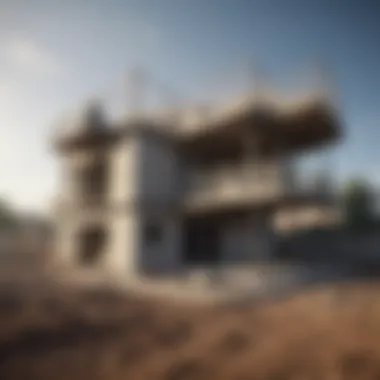Complete Guide to Building a Duplex House


Intro
Constructing a duplex house requires not only creativity but also meticulous planning. This comprehensive guide aims to equip readers with essential knowledge about the process from start to finish. Whether you're a homeowner considering a duplex for your family or a real estate professional seeking insights on building design, many factors play a crucial role in creating an effective and functional space.
Understanding concepts such as zoning laws, architectural styles, and site selection will help navigate the complex landscape of duplex construction. With this guide, you will gain clarity on each stage of this journey.
Home Features
A duplex house combines two units that can share walls or be fully separated. This design promotes efficient use of space, making it an attractive choice for many. Below, we examine some of the integral features that make duplex architecture distinct.
Architectural Marvels
Duplex houses can showcase a variety of architectural styles. For instance, a modern duplex may feature clean lines and large windows that optimize natural light. Conversely, traditional designs could include ornate details and pitched roofs.
Some architectural elements to consider include:
- Facade variations: Using different materials like brick, wood, or siding to create visual interest.
- Balconies or terraces: These provide outdoor space while enhancing aesthetics.
- Energy-efficient designs: Incorporating sustainable materials and systems can lower utility bills and reduce the environmental impact.
Unique Design Elements
Each duplex can reflect personal taste through unique design features. Consider these elements:
- Open floor plans: This enhances space and allows a sense of flow between living areas.
- Private entrances: Ensures each unit feels individual and accessible.
- Innovative storage solutions: Maximizing vertical space with built-ins or clever cabinetry can significantly enhance usability.
"Understanding the architectural intricacies of a duplex is essential for anyone involved in the design process."
Interior Design Inspirations
Interior spaces in a duplex are often as crucial as exterior features. Well-thought-out interior design can create a harmonious living environment.
Color Palettes and Themes
Color significantly influences the ambiance of a home. For duplex spaces, consider:
- Neutral base colors: Providing a calm canvas that can be accented with vibrant accessories.
- Cohesive themes: Whether modern, minimalist, or rustic, sticking to a theme will create a unified look throughout the duplex.
Furniture Arrangement Tips
The layout of furniture can optimize space and improve functionality in a duplex. Suggestions include:
- Zone different areas: Use rugs or furniture placement to define living, dining, and cooking spaces.
- Scale furniture appropriately: Select pieces that fit the dimension of the rooms without overwhelming them.
In summary, building a duplex house involves many steps, from choosing architectural styles to furniture placement. Each decision contributes to the overall success of the project. By understanding these elements, you will be better prepared for the challenges and rewards of duplex construction.
Understanding Duplex Houses
Understanding duplex houses is fundamental to the overall process of planning and constructing such a property. A duplex, essentially, is a type of residential building that consists of two separate living units. These units can either be side-by-side or stacked vertically. Recognizing the distinct characteristics and advantages of duplex homes provides a framework for potential homeowners and investors to make informed decisions.
Definition and Characteristics
A duplex house is defined as a single building that contains two separate housing units. Each unit is designed to accommodate a family or individuals, offering the privacy similar to a detached home. Duplexes typically share a common wall if they are side-by-side, meaning they utilize the space efficiently while providing two distinct living areas.
Several characteristics define a duplex:


- Independence: Each unit has its entrance, kitchen, and bathroom, allowing for independent living.
- Shared Infrastructure: Utilities like plumbing and electrical systems may be shared or separate.
- Design Flexibility: Duplexes can be customized in a variety of architectural styles and layouts, catering to different preferences and needs.
Duplexes can vary in size, functionality, and design. Many modern versions utilize eco-friendly materials and energy-efficient technologies to reduce the environmental footprint.
Benefits of Building a Duplex
Building a duplex presents various benefits that are often appealing to homeowners and investors alike. Here are some key advantages:
- Increased Income Potential: If one unit is rented out, it can provide a steady income stream, assisting with mortgage payments.
- Affordable Living: Duplexes can be more cost-effective than buying two separate homes, especially in urban settings where housing prices are high.
- Community and Proximity: Duplexes allow families or friends to live close to each other, offering social interaction and support while maintaining personal space.
- Property Value Appreciation: Over time, duplexes often appreciate in value due to their multifunctional nature, making them a sound investment.
- Flexibility in Use: Homeowners can choose to use one unit as a guest home, workspace, or for aging family members.
The design and layout of duplex homes not only contributes to their appeal but also enhances the possibilities for long-term financial investments.
Planning and Design Phase
The planning and design phase is crucial when building a duplex house. This stage sets the foundation for the entire project. Careful thought at this moment can prevent costly adjustments down the line. It is not only about having a solid architectural plan. It involves understanding local regulations, site selection, budget constraints, and even considering the future needs of potential occupants.
Site Selection Criteria
Site selection greatly impacts the functionality and success of the duplex. Geographic location, proximity to amenities, and environmental factors should all be evaluated. It is essential to choose a site that allows for good accessibility. Factors such as schools, public transport, and shopping centers contribute to the appeal of living in a duplex. Zoning regulations may limit certain locations, which brings us to another important aspect to consider.
Understanding Local Zoning Laws
Zoning laws dictate how land can be used in a particular area. Understanding these laws is paramount. Each locality may have different requirements for duplex constructions. For example, setbacks, height restrictions, and density regulations must all align with local laws. Neglecting these can lead to legal issues or even project termination. Therefore, before finalizing site selection, it is wise to consult local zoning laws to ensure compliance.
Architectural Layout Options
When it comes to duplex designs, there are typically two predominant layout options: side-by-side duplex and stacked duplex.
Side-by-Side Duplex
Side-by-side duplexes involve two units placed next to each other. This layout is popular for several reasons. One key characteristic is the independence it offers each unit. Owners have more privacy since walls separate living spaces. Additionally, this design can foster a sense of community while still providing personal space. However, it requires more land than a stacked layout, potentially increasing costs. Shorter, wider land parcels work best with this option.
Stacked Duplex
The stacked duplex consists of two units stacked on top of each other. This design is beneficial in areas with limited space. By building vertically, homeowners can maximize the use of the land. A key characteristic of a stacked duplex is its efficient use of space, making it a cost-effective solution. However, this layout may result in less privacy between units compared to the side-by-side option. Furthermore, noise can be a concern if floor insulation is not properly installed.
Interior Design Considerations
The interior design of a duplex should reflect functionality as well as style. This is where the personality of the house truly shines. Owners should think about the layout flow to make sure it is practical. Space usage is critical, especially in smaller units. Open floor plans may enhance the feeling of spaciousness. Consideration of natural light and color schemes adds to the ambiance. How the design can cater to both families residing in each unit is also a significant factor. Utilizing common spaces effectively can enhance the living experience for everyone involved.
Budgeting for a Duplex Build
Budgeting is a critical aspect of constructing a duplex house. It influences every decision throughout the building process. Proper financial planning ensures that you can meet construction goals without unexpected expenses interfering. Furthermore, this phase can determine how much you can allocate to various features, such as materials, design, and even landscaping.
Estimating Construction Costs
Estimating construction costs involves a detailed assessment of all financial elements necessary for building a duplex. You will need to account for the following:
- Land Acquisition: If you do not already own a plot, purchasing land will be a significant initial cost.
- Material Costs: Prices of lumber, bricks, roofing, and finishes can fluctuate. Researching current material prices will give you a clearer picture.
- Labor Costs: Identify contractors’ rates. Skilled labor is essential and often comes at a premium.
- Permitting Fees: Local zoning laws may require different permits and approvals, which incur fees.
- Utilities Installation: Connecting your duplex to water, electricity, and sewage may also add costs.
An in-depth cost estimate should be based on tangible quotes received from suppliers and contractors. It might also be advisable to include contingency funds, generally around 10-15%, to cover unforeseen expenses.
Financing Options Available


Financing a duplex can take multiple avenues. It’s essential to explore various options to find what suits you best:
- Mortgages: Most homeowners utilize mortgages when financing a duplex. Traditional banks and credit unions may offer loans with competitive interest rates.
- Construction Loans: These are short-term loans specifically for building purposes. Their structure helps manage cash flow during construction.
- Home Equity Loans: If you own a property, leveraging its equity can provide funds for your duplex build.
- Investors or Partnerships: In some cases, enlisting an investor or partnering with a friend can help share costs and risks.
Each option has unique features and requirements. It’s crucial to thoroughly understand these before making a commitment.
Cost-Benefit Analysis of Duplexes
Evaluating the cost-benefit ratio of building a duplex is essential. Duplex homes can serve both personal and investment purposes. Here are some factors to consider:
- Rental Income Potential: If you decide to rent one side of your duplex, it can significantly offset your mortgage payments.
- Property Value Appreciation: Real estate generally appreciates over time. With a well-built duplex, you can expect increased property value in the long term.
- Maintenance Costs: Consider the implications of shared walls and systems. This can lead to reduced maintenance costs over time.
- Flexibility: A duplex allows for versatile living arrangements, which can be advantageous if family or friends need housing in the future.
"Investing in a duplex might come with higher upfront costs, but the potential for long-term returns makes it a worthy consideration for many homeowners."
Choosing the Right Contractors
Choosing the right contractors is crucial in the construction of a duplex house. The contractor's expertise and reliability can significantly influence the project’s success. A competent contractor can navigate challenges that arise during construction and ensure that all work adheres to local building codes. Conversely, hiring the wrong contractor can lead to delays, increased costs, and compromised quality. Therefore, a careful selection is necessary.
Evaluating Contractor Qualifications
To evaluate contractor qualifications, one must focus on several critical factors.
- Experience: Look for contractors who have experience specifically with duplex constructions. They will understand the unique challenges and requirements that such projects entail.
- Licensing and Insurance: Confirm that the contractor is properly licensed to work in your area. Additionally, they should have liability insurance and worker’s compensation. This protects you from financial stress if accidents occur on-site.
- References and Reviews: Ask for references from previous clients. Check online reviews and ratings. Previous work can showcase a contractor's reliability and quality of work.
- Communication Skills: Good communication is essential. A contractor should be able to explain processes clearly and be responsive to inquiries. This ensures a smoother workflow throughout the project.
- Payment Terms: Understand their payment structure. A trustworthy contractor provides a clear outline of payment schedules tied to specific milestones.
These aspects form the foundation of a thorough evaluation process. Without these checks, potential issues may not be identified until it is too late.
Understanding Contract Types
When engaging a contractor, understanding the different contract types is essential. Each type has distinct implications for your project.
- Fixed-Price Contracts: This contract type offers a set price for the entire project. It can provide predictability in budgeting, but be cautious of hidden costs tucked into the bid.
- Cost-Plus Contracts: Here, the contractor is paid for their actual costs, plus an additional fee for profit. This type can motivate high-quality work since the contractor bears some of the financial risk. However, it requires diligent oversight to avoid excessive costs.
- Time and Materials Contracts: In this scenario, costs are based on the time spent and materials used. This can be ideal for projects where the scope isn't fully defined. Yet, it can lead to unexpected expenses.
- Design-Build Contracts: A single entity handles both design and construction. This can streamline communication and reduce likelihood of delays. However, ensure that the contractor has a solid design background.
Understanding the nature of these contracts helps in making informed decisions. Each has pros and cons that align differently with various project types.
"Selecting the right contractor sets the tone for the entire building process, influencing timelines, costs, and quality."
In summary, tt is imperative to invest time in choosing a contractor. Prioritize qualifications and grasp contract types to safeguard your project's success.
Construction Process Overview
In the journey of building a duplex house, the construction process overview serves as a framework that outlines the entire operational flow. This phase is crucial as it bridges the planning and design stage with the physical construction, ensuring that each step aligns with the project's objectives and regulatory requirements. Understanding the various components involved can significantly impact the project timeline, budget, and final outcome.
Having a clear grasp of the construction process brings several benefits. First, it helps in coordinating multiple tasks effectively. With proper planning, contractors can identify dependencies between tasks which minimizes delays. Second, it ensures compliance with local building codes and safety standards, a critical factor in avoiding costly revisions later in the project.
Finally, it fosters better communication among stakeholders, from homeowners to builders. Each party involved can have clear expectations and responsibilities, which leads to smoother collaborations. Overall, mastering the nuances of the construction process overview is essential for a successful duplex build.
Permits and Approvals
Obtaining the right permits and approvals is a crucial first step in the construction process. Before any physical work begins, homeowners must ensure compliance with local regulations. This typically includes permits for land use, construction, and utility connections. Engaging with local authorities early can prevent delays and potential fines.
During this phase, it is advisable to prepare all required documentation, which may include property surveys, environmental impact assessments, and architectural plans. This thorough preparation helps streamline the approval process, paving the way for subsequent phases of construction.
Groundwork and Foundation


The groundwork and foundation stage is fundamental to the integrity and durability of the duplex. This step involves excavation, laying a solid base, and constructing footings. The foundation type, whether slab, crawl space, or basement, will depend on soil conditions and local building practices.
A properly constructed foundation prevents future structural issues. It is essential to adhere to engineering specifications and local codes during this phase. Skimping on this step can result in significant long-term costs related to repairs and stabilization.
Framing Considerations
Framing is the skeleton of the duplex, providing the structure upon which all other elements depend. This stage includes constructing walls, floors, and ceilings. The choice of materials influences both cost and building performance. Common materials include wood and steel, each with their benefits and drawbacks.
Wood framing is lightweight and easier to work with, while steel offers superior strength and resistance to pests. Additionally, framing must also account for design features like windows, doors, and roof lines which need to be accurately laid out during this phase.
Systems Installation
The proper installation of vital systems is necessary for functionality.
Electrical Systems
Electrical systems underpin the livability of the duplex. The installation phase includes wiring, outlets, and lighting fixtures. A key consideration here is complying with local electrical codes to ensure safety and performance.
One distinguishing feature of modern electrical designs is smart home integration, which allows homeowners to control systems remotely. While initially more expensive, this choice enhances comfort and energy management.
Plumbing
Effective plumbing installation ensures adequate water supply and waste management throughout the duplex. This includes the installation of pipes, fixtures, and appliances like sinks and toilets. Adhering to local plumbing codes is mandatory to prevent future leaks and water damage.
A notable characteristic of optimal plumbing systems is the use of materials such as PEX or copper, which offer longevity and efficiency. Choosing the right material impacts both performance and costs.
HVAC
Heating, ventilation, and air conditioning (HVAC) systems are critical for maintaining comfort in the duplex. This involves installing ductwork, furnaces, and air conditioning units. Selecting an appropriate HVAC system can dramatically impact energy efficiency and indoor air quality.
Geothermal heat pumps and high-efficiency units are popular choices today, emphasizing environmental considerations. However, installation complexity may be a downside, requiring professional expertise.
Finishing Touches
The finishing touches mark the final stage of construction. This phase includes painting, flooring installation, and other aesthetic elements that transform the structure into a livable space. Carefully chosen finishes distinguish a well-built duplex from an ordinary one.
Attention to detail becomes essential at this stage. Quality materials and skilled craftsmanship can elevate the overall look and feel of the home. Additionally, engaging with interior designers can ensure cohesion between various design elements and functionality.
Post-Construction Considerations
After the physical structure of a duplex is complete, you encounter a series of important elements that cannot be overlooked.
Inspection and Handover
The final inspection process serves as the last quality check before officially moving into a new duplex. Local building authorities usually mandate that inspections are completed to ensure compliance with safety standards, building codes, and zoning laws. This inspection often includes evaluating the structural integrity, electrical and plumbing systems, and overall safety features.
It is wise for homeowners to conduct a walkthrough with the contractor or project manager during this time. Document any issues found and ensure that they are rectified before handover. Proper documentation and communication can prevent future disputes. Once everything is satisfactory, you will receive a certificate of occupancy which allows you to legally inhabit the space.
Long-term Maintenance
Maintaining a duplex requires regular attention. It is not just about aesthetic appeal; regular maintenance helps in preserving the property’s value and functionality over time. Homeowners should create a scheduled maintenance plan that includes checking the roofing, HVAC systems, and plumbing at least once a year.
In addition, seasonal tasks such as cleaning gutters or checking the heating systems during winter months are equally important. Failure to adhere to maintenance could lead to larger, more expensive repairs in the future. By being proactive, you ensure that both units in the duplex remain in good condition, allowing for longevity and minimizing disruptions.
Potential Income Generation
A duplex can serve as a significant income-generating asset. Renting out one side of the duplex creates a steady stream of passive income. This can help in offsetting mortgage payments and other expenses associated with the property.
It’s essential to understand specific local regulations regarding rental properties. Landlords must comply with tenant laws and secure necessary permits for renting. Excellent property management can lead to high tenant retention rates, further maximizing profitability.



